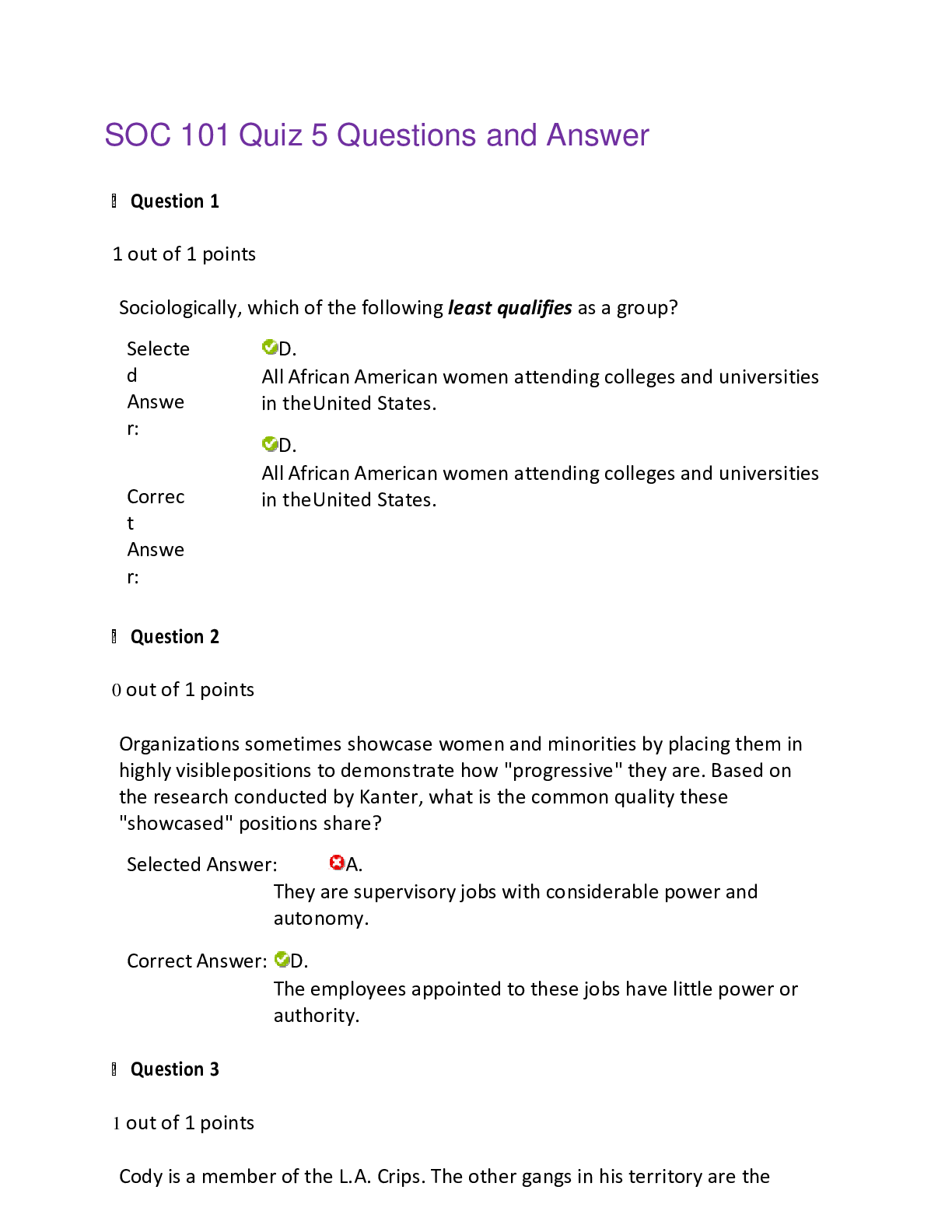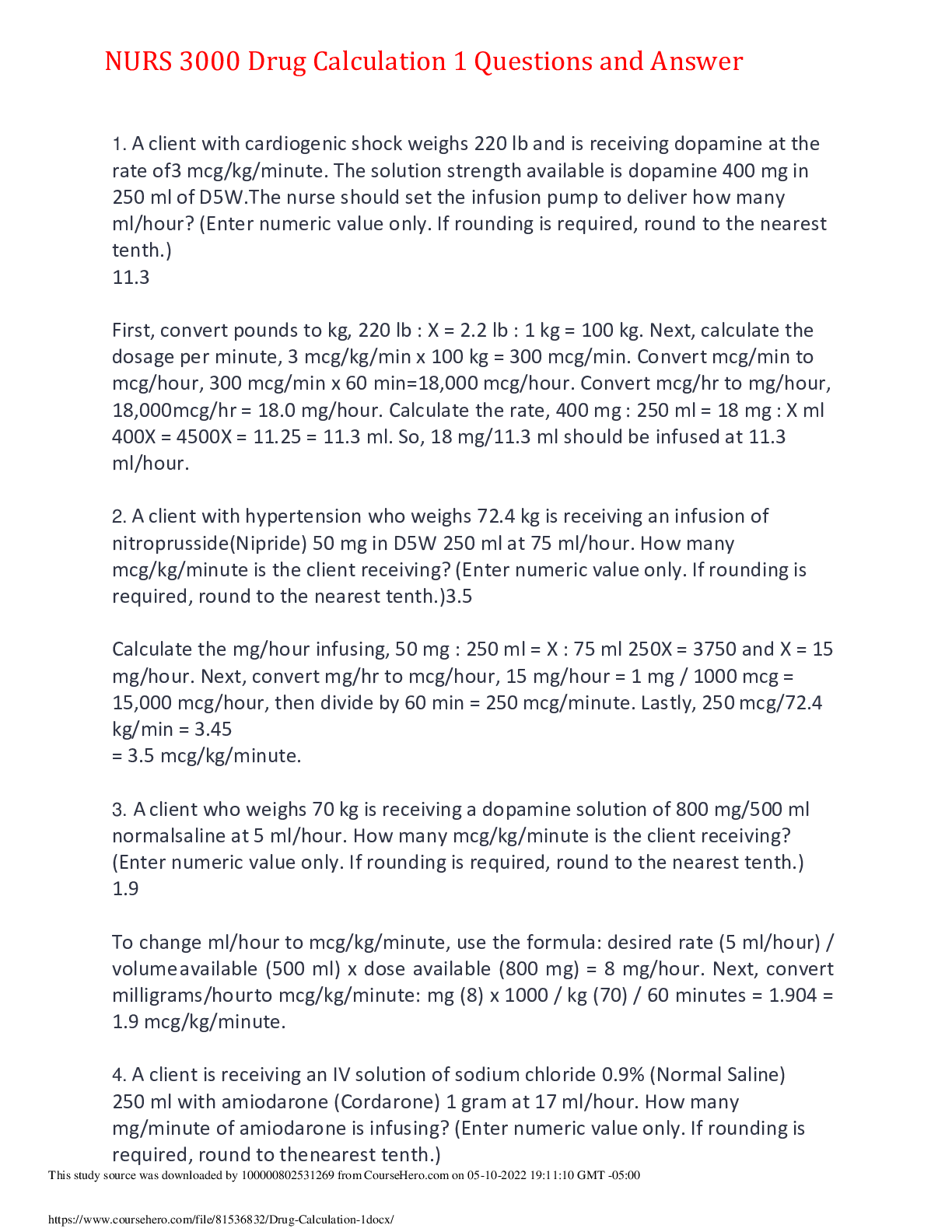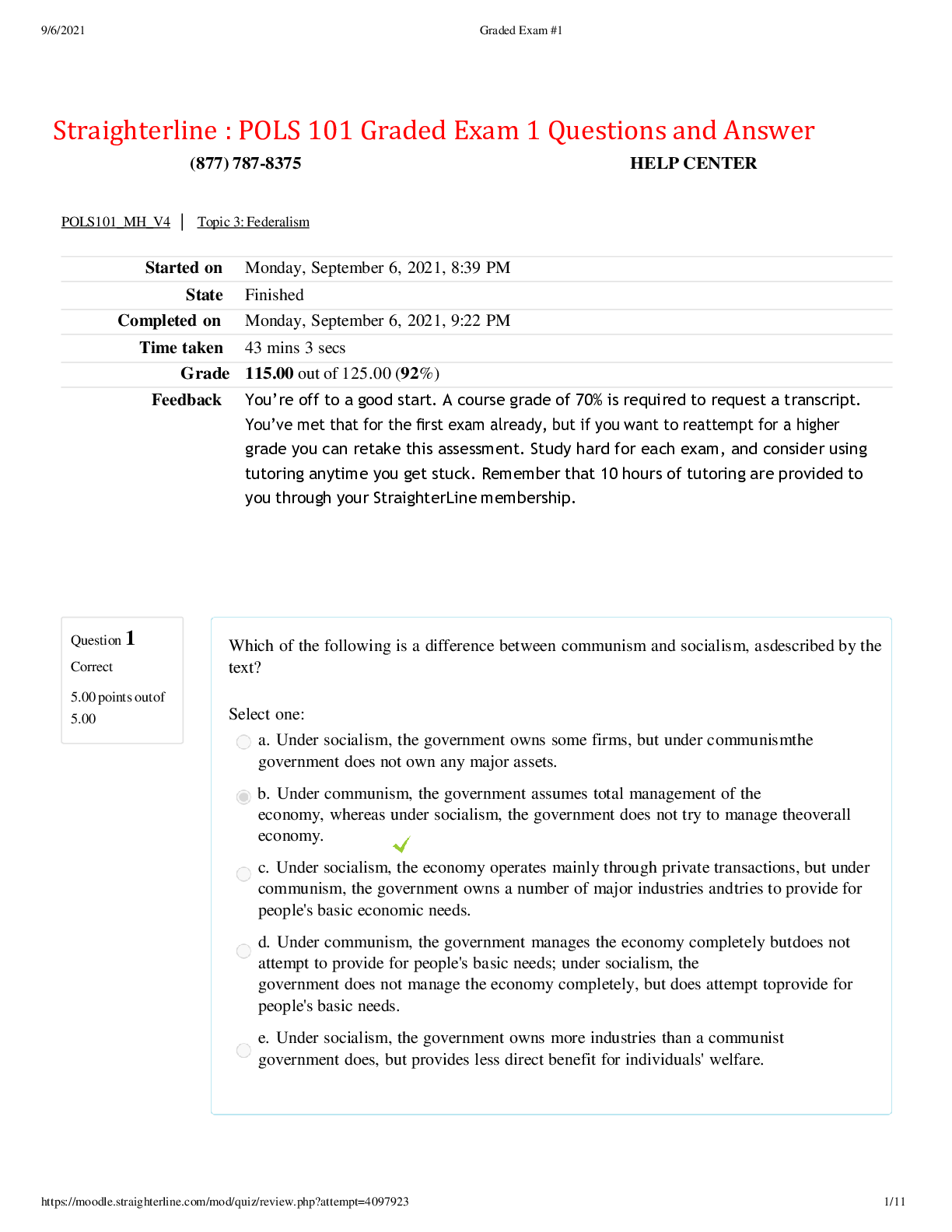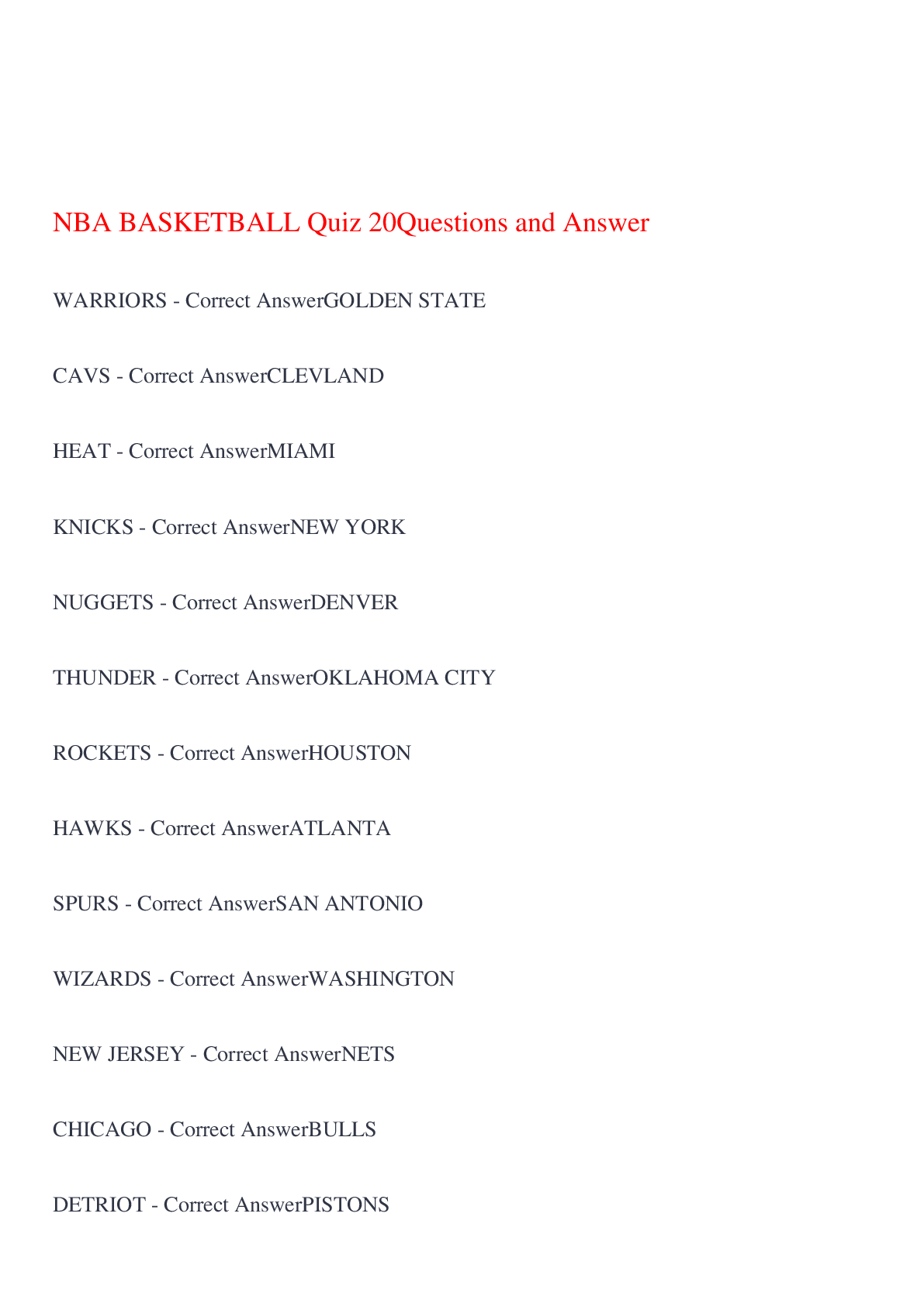IHI PS 101 Study question and answer,100% CORRECT
Document Content and Description Below
IHI PS 101 Study question and answer According to WHO, in developed countries worldwide, what is the approximate likelihood that a hospitalized patient will be harmed while receiving care? ... A <1% B 10% C 50% D >75% B 10% Since the publication of To Err Is Human in 1999, the health care industry overall has seen which of the following improvements? (A) A 75 percent reduction in preventable medical errors (B) Stronger repercussions for providers who commit preventable medical errors (C) Wider awareness that preventable errors are a problem (D) Wider recognition that medical errors are most often attributable to individual performance (E) All of the above C wider awareness that preventable errors are a problem Safety has been called a "dynamic non-event" because when humans are in a potentially hazardous environment: (A) It is natural to establish and follow safe practices (B) It requires the same kind of thinking that causes problems to set them right (C) It takes significant work to ensure nothing bad happens (D) There is generally a high prevalence of "near misses" C it take significant work to ensure nothing bad happens James is a first-year surgery resident on his first pediatric rotation. His attending (consultant) asks him to start intravenous (IV) replacement fluids on a two-year-old boy who is having vomiting and diarrhea. Having trouble remembering the guidelines for calculating fluid replacement rates for very small children, James asks Maria, a nurse on the unit. Maria responds, "You're the doctor. It's your job to decide this." James picks a rate that is much too high, putting the child into fluid overload. To prevent this type of error from recurring in this unit, which of the following is MOST important? (A) Clear medical guidelines for fluid replacement in patients of all ages (B) An improved culture of safety and teamwork (C) Closer supervision of residents, especially in the first year (D) More severe, well-publicized consequences for providers who are reckless B an improved culture of teamwork and safety James is a first-year surgery resident on his first pediatric rotation. His attending (consultant) asks him to start intravenous (IV) replacement fluids on a two-year-old boy who is having vomiting and diarrhea. Having trouble remembering the guidelines for calculating fluid replacement rates for very small children, James asks Maria, a nurse on the unit. Maria responds, "You're the doctor. It's your job to decide this." James picks a rate that is much too high, putting the child into fluid overload. Who is likely to be negatively affected by this medical error? (A) The patient and his family (B) James (the first-year surgery resident) (C) Maria (the nurse on the unit) (D) All of the above D all of the above Approximately what percentage of US adults have experienced a medical error in their own or a family member's care at some point in their life? (A) 1 percent (B) 5 percent (C) 33 percent (D) 66 percent c 33% "Patient safety" means: (A) Eliminating medical error and preventable harm in health care (B) Eliminating waste in health care services (C) Eliminating health inequities in populations (D) All of the above eliminating medical error and preventable harm in health care James is a first-year surgery resident on his first pediatric rotation. His attending (consultant) asks him to immediately start intravenous (IV) replacement fluids on a two-year-old boy who is experiencing vomiting and diarrhea. James has recently learned the guidelines for calculating fluid replacement rates for very small children; however, he confuses them and picks a rate that is too high. Which of the following reasons that errors often occur in health care most clearly played a role in this scenario? (A) Diagnosing and treating patients is incredibly complex and often performed under time pressure and/or with insufficient information. (B) The "culture of safety" (meaning the attitudes, perceptions, and values that employees share in relation to safety) may be weak in health care compared to other high-risk industries. (C) Providers may not be prepared to work as a well-integrated team, so multiple caregivers and patient handovers leave room for miscommunication at every turn. (D) The science of medicine is filled with nuance and gray areas, and what one health care organization feels is good practice, another may not. Diagnosing and treating patients in incredibly complex and often performed under time pressure and/or with insufficient information. Since the IOM published To Err Is Human in 1999, the health care industry has seen which of the following improvements? (A) A drastic reduction in preventable medical errors (B) Stronger repercussions for providers who commit medical errors (C) Wider recognition that medical errors are most often attributable to individual performance (D) None of the above none of the above James is a first-year surgery resident on his first pediatric rotation. His attending (consultant) asks him to immediately start intravenous (IV) replacement fluids on a two-year-old boy who is experiencing vomiting and diarrhea. James has recently learned the guidelines for calculating fluid replacement rates for very small children; however, he confuses them and picks a rate that is too high. To prevent this type of error from recurring in this unit, which of the following is MOST important? (A) Clearer medical guidelines for fluid replacement in patients of all ages (B) An improved culture of safety (C) A change to the system, so that it does not rely as heavily on human memory (D) More severe, well-publicized consequences for providers who are reckless (C) A change to the system, so that it does not rely as heavily on human memory What is most likely to happen if a health system punishes an individual for an unintended error that was the result of a systems problem? (A) Staff may be less likely to talk openly about and learn from errors. (B) Staff will be more careful and errors will decrease. (C) The response will weaken the safety culture. (D) A and C (D) A and C Which of the following statements is true about blame and punishment of individuals for making errors? (A) They can undo the error. (B) They can prevent the error from happening again. (C) They can be appropriate responses if that individual intentionally caused harm. (D) All of the above They can be appropriate responses if that individual intentionally caused harm. 00:0201:47 Upgrade to remove ads Only $35.99/year A colleague accesses and delivers a medication, believing it is the correct one. Unfortunately, it isn't — it is another medication in a similar vial. Which of the following is the best way to address his error? (A) Ask him to take a couple of weeks off without pay. (B) Make sure that he is supervised more closely in the future. (C) Send an email to him as well as others who administer those medications to remind them that the vials look similar. (D) Investigate whether others find the vials confusing and consider making a change to how they are packaged or accessed. (D) Investigate whether others find the vials confusing and consider making a change to how they are packaged or accessed. When an error occurs, which of the following is a productive response? (A) Interview all participants in the process to determine what happened. (B) Suspend the licenses of everyone involved. (C) Determine if reasonable changes can be made to prevent the same type of error in the future. (D) A and C (D) A and C Which of the following situations seems to warrant punitive action? (A) A colleague routinely refuses to perform a mandatory safety process. (B) A colleague is involved in the same type of error more than once. (C) A colleague makes a mistake because she is distracted. (D) All of the above (A) A colleague routinely refuses to perform a mandatory safety process. Which of the following statements is true? (A) Blaming and punishing an individual for making an error can undo the error. (B) Blaming and punishing an individual for making an error can prevent the error from happening again. (C) Blaming and punishing an individual for making an error is never appropriate, in any circumstance. (D) None of the above (D) None of the above After a medical error occurs, what is the best way to prevent the same error from happening again? (A) Punish everyone involved in the error. (B) Change the system in which the error occurred. (C) Permanently dismiss everyone who was involved in the error. (D) The same error is unlikely to happen more than once, so no action is required. (B) Change the system in which the error occurred. A patient in your colleague's care suffers minor harm due to a medication mix-up. In which of the following situations might some type of punitive action against your colleague be warranted? (A) She was under the influence of illicit drugs when the error occurred. (B) She accidentally administered the wrong medication although trying her best. (C) She ignored proper protocol for dispensing the medication because she resented being told what to do. (D) A and C (D) A and C When an error occurs, which of the following is a productive response? (A) Interview all participants in the process to determine fault and place blame. (B) Suspend the licenses of everyone involved. (C) Determine if reasonable changes can be made to prevent the same type of error in the future. (D) A and C (C) Determine if reasonable changes can be made to prevent the same type of error in the future. Which of these is a behavior providers should adopt to improve patient safety? (A) Develop ways to work around broken systems (B) Ignore patients' individual preferences when they disagree with "best practice" (C) Follow written safety protocols, even if they slow you down (D) Obey your superiors without question (E) All of the above (C) Follow written safety protocols, even if they slow you down After a team training system is implemented in an operating room (OR), a junior circulating nurse notices that a particular anesthesiologist goes missing from the OR at odd times, often seems sluggish, and occasionally slurs her words. Concerned that the physician might be impaired due to medication abuse, the nurse ponders what to do next. What would be the MOST appropriate way for the nurse to respond? (A) Call the physician at home and warn her to stop abusing prescription medication (B) Refuse to work with that physician in the future (C) Start logging the suspicious occurrences as he sees them, so that he can bring a list to the medical director (D) Talk to the medical director now, in confidence (E) Warn colleagues about working with that physician (D) Talk to the medical director now, in confidence When it comes to self-care, which of the following statements is true? (A) If you're especially stressed because of a divorce, it may adversely affect your performance (B) Lack of sleep can be similar to being drunk (C) Spending quality time with friends can make you a safer health care provider (D) All of the above (D) All of the above Janet is a new physical therapist on the orthopedic surgery unit. Although learning a new position has been exhausting and somewhat stressful, she remains excited about the opportunity, and two weeks into her new job she has already volunteered to take on extra patients while a colleague is away. Today, she has 16 patients, one of whom is George Martinez. He is a 47-year-old man who had a left knee replacement two days ago. She goes to see Mr. Martinez in Room six. For privacy reasons, patients' first names are not listed outside the doors on Janet's unit, so she does not realize she is walking into the wrong patient's room, and she does not check the patient's name on his wristband as protocol indicates she should. She is now in the room of Rudy Martinez, a 56-year-old man who had an emergent left knee repair yesterday for a torn meniscus. Janet starts to bend his knee, causing him to yell in pain. Worried, Janet finds George Martinez's nurse and tells her about the situation and background of the problem, as well as her assessment that something must be wrong. Which of the following critical behavior(s) did Janet violate? (A) Follow safety protocols (B) Speak up when you have concerns (C) Take care of yourself (E) A and C E, A & C Which of the following techniques represent best practice for communicating with patients and families? (A) Listen to and honor patient and family perspectives and choices. (B) Identify a patient's and family's knowledge, values, beliefs, and cultural background. (C) Encourage patients and families to participate in care and decision-making at the level they choose. (D) All of the above (D) All of the above [Show More]
Last updated: 1 year ago
Preview 1 out of 19 pages

Buy this document to get the full access instantly
Instant Download Access after purchase
Add to cartInstant download
We Accept:

Reviews( 0 )
$14.00
Document information
Connected school, study & course
About the document
Uploaded On
Oct 13, 2022
Number of pages
19
Written in
Additional information
This document has been written for:
Uploaded
Oct 13, 2022
Downloads
0
Views
115






















